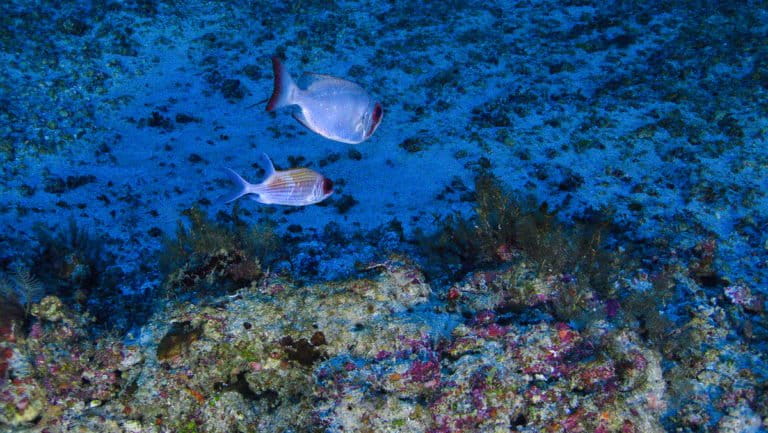- Extending from French Guiana to Maranhão State in northern Brazil, the Amazon Reef is a 9500-square-kilometer (or nearly 3,700-square-mile) system of corals, sponges, and rhodoliths (a colorful marine algae that resembles coral) located where the Amazon River meets the Atlantic Ocean — a region currently threatened by oil exploration activities.
- When the reef was discovered in April 2016, Fabiano Thompson of Brazil’s Universidade Federal de Pernambuco, who was part of the team of scientists who made the discovery, told Mongabay that “The oceanographic conditions (biogeochemistry and microbiology) of this system are unique, not found in other places of the planet.”
- The mouth of the Amazon River basin also provides valuable habitat for a range of species, including the American manatee, the yellow-spotted Amazon river turtle, dolphins, and giant river otters, which are listed as Endangered on the IUCN’s Red List.
Greenpeace has released the first-ever underwater photos of a coral reef discovered at the mouth of the Amazon River last year.
Extending from French Guiana to Maranhão State in northern Brazil, the Amazon Reef is a 9,500-square-kilometer (or nearly 3,700-square-mile) system of corals, sponges, and rhodoliths (a colorful marine algae that resembles coral) located where the Amazon River meets the Atlantic Ocean — a region currently threatened by oil exploration activities.
By the time water has traveled the length of the Amazon River, it is carrying a lot of mud and sediment. These turbid and nutrient-rich waters cloud the surface of the Atlantic, allowing very little light to penetrate. While that may make for an unlikely place to find a reef habitat, it also means that the Amazon Reef has evolved into a unique ecosystem found nowhere else on Earth.
In response to the Brazilian government opening the area for oil exploration, Greenpeace has launched a campaign to protect the Amazon Reef. A team of experts, including several of the oceanographers who discovered the reef last year, joined Greenpeace activists on an expedition to document the rare biome. The photos of the Amazon Reef were taken by the crew of a submarine launched from the Greenpeace ship MY Esperanza.

“This reef system is important for many reasons, including the fact that it has unique characteristics regarding use and availability of light, and physicochemical water conditions. It has a huge potential for new species, and it is also important for the economic well-being of fishing communities along the Amazonian Coastal Zone,” said Nils Asp, a researcher with Brazil’s Federal University of Pará who helped discover the reef and is taking part in the Greenpeace expedition.
“Our team wants to have a better understanding of how this ecosystem works, including important questions like its photosynthesis mechanisms with very limited light. Hopefully, this will lead to a gradual mapping of the reef system.” Less than five percent of the ecosystem has been mapped to date, Asp added.
When the reef was discovered in April 2016, Fabiano Thompson of Brazil’s Universidade Federal de Pernambuco, who was also part of the team of scientists that made the discovery and is onboard the Esperanza, told Mongabay that “The oceanographic conditions (biogeochemistry and microbiology) of this system are unique, not found in other places of the planet.”
Thompson, Asp, and the other authors of a study documenting the newly discovered reef, published in Science Advances last April, said at the time that the Amazon Reef could provide insights into how coral ecosystems will fare as global temperatures continue to climb.
The mouth of the Amazon River basin provides valuable habitat for a range of species, including the American manatee, the yellow-spotted Amazon river turtle, dolphins, and giant river otters, which are listed as Endangered on the IUCN’s Red List. Local fishermen and more than 80 Quilombola communities rely on the area for their livelihoods, as well.
Oil companies Total and BP could start drilling in the surrounding area as soon as they obtain final authorization from the Brazilian government, according to Greenpeace. As the group notes, Cape Orange National Park, in the Brazilian state of Amapá (which is where the mouth of the Amazon River is located), is home to the world’s largest continuous mangrove ecosystem, and there is no current technology capable of removing any oil that might be spilled in such an environment. Some 95 wells have already been drilled in the region, Greenpeace said.
“One of Total’s oil blocks is only eight kilometers from the reef, and environmental licensing processes are already under way,” Thiago Almeida, a campaigner with Greenpeace Brazil, said in a statement.
“After ratifying the Paris Agreement, [Brazilian] President Michel Temer declared that the climate issue is an obligation for all governments. If Brazil’s commitment is serious, we must prevent the exploration of oil in the region and keep fossil fuels in the ground to avoid climate catastrophe.”











CITATION
- Moura, R.L., Paranhos, R.P., Leal, C.V., et. al. (2016). An extensive reef system at the Amazon River mouth. Science Advances. doi:10.1126/sciadv.1501252
FEEDBACK: Use this form to send a message to the author of this post. If you want to post a public comment, you can do that at the bottom of the page.